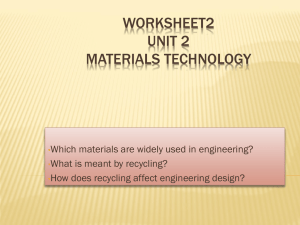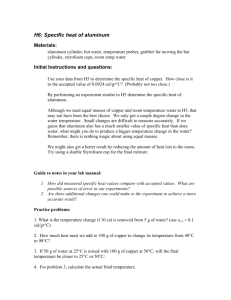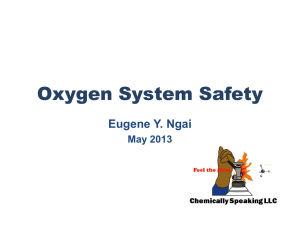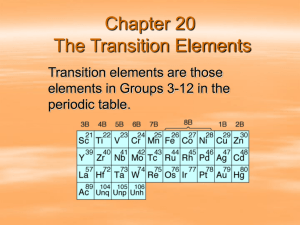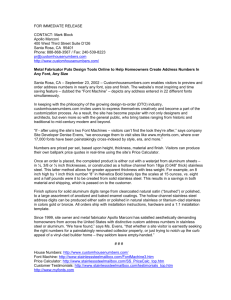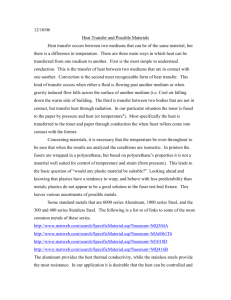Part II: Metal Systems and Architecture 1. Properties of metals
advertisement
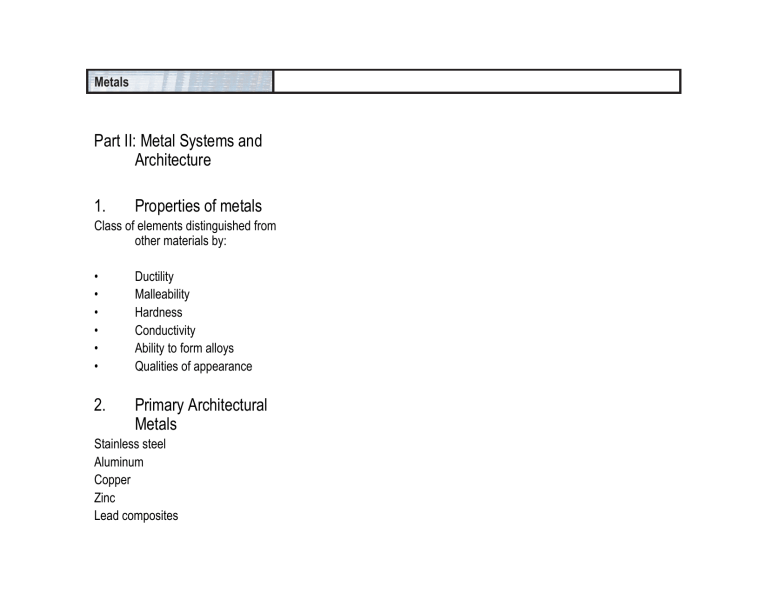
Metals Part II: Metal Systems and Architecture 1. Properties of metals Class of elements distinguished from other materials by: • • • • • • Ductility Malleability Hardness Conductivity Ability to form alloys Qualities of appearance 2. Primary Architectural Metals Stainless steel Aluminum Copper Zinc Lead composites Metals Introduction Of all known elements, metals make up the majority.Within periodic table there are five separate families of metals 1. Alkali metals: very reactive metals, none of these used in architecture. 2. Alkaline earth metals: magnesium and beryllium are used as alloyins constitutents. Otherwise not used for architectural applications. 3. First transition metals: known for hardness and strength, especially when tungsten, chromium and vanadium are used as alloying agents. 4. Second transition metals: iron is major architectural element of this group. Nickel is alloyed with copper to produce monel and with iron and steel to produce the stainless steels. 5. Third transition metals: included here are copper, silver, zinc. All of these play an architectural role. Zinc and copper are sought for their superior stability in atmospheric conditions. Metal-like elements: with both metal and nonmetallic properties 1. Boron and carbon family: includes the oldest architectural metal, lead and the newest, aluminum. 2. Rare earth metals: not architecturally significant. 3. Nitrogen and oxygen group First transition metals titanium, chromium, molybdenum, tungsten, manganese Second transition metals iron, cobalt, nickel, platinum Third transition metals copper, silver, gold, zinc, cadmium, mercury Boron and carbon families Lead, tin, aluminum COPYRIGHT JOHN E. FERNANDEZ: BUILDING TECHNOLOGY GROUP: MIT Metals Weathering and corrosion resistance • • • • • Metals age with the formation of oxides and hydroxides on their surfaces. Often this layer is more layered, roughened surface that reduces the reflectivity. Generally, a smoother surface will resist corrosion better. A smoother surface will offer less surface area for atmospheric penetration. A smooth surface also selfcleans better (mostly with rain and snow). In coastal climates, the presence of chlorides from salt is the primary agent of corrosion. Salts will accumulate in dews and other moisture forming on the cool metal surface. Salt deposits become concentrated at edges, drips and horizontal edges. In urban/industrial environments corrosion occurs through the attack the surface by sulfur dioxide, which combines with moisture to develop sulfuric acid, which can stain and deteriorate many metals. Most metals are susceptible, includin stainless steels. Regular cleaning and maintenance is required. Environments of exposure are ranked as follows: Most Severe salts) Marine Coastal Urban Northern Urban Street Level (road Urban Industrial Coastal Urban Urban-Arid climate Urban-Protected Arctic Rural Interior-Entrances Interior Interior-Protected Least Severe Metals Appropriate environments 1 = Rural environments 2 = Urban, industrial 3 = Coastal Performance G = Good M = Moderate P = Poor Env Titanium Stainless steel Monel Copper Lead Painted alum. Ptd zinccoated steel Zinc Aluminum Steel Polished brass and bronze 1 G G G G G G G G G M+ G 2 M+ M+ G G G M M M P P P 3 G M+ G G G P P P P P P Metals Weathering and corrosion resistance Metal Color Reflectivity (1=high, 5=low) 10-year aging characteristics Zinc-natural Gray-blue 2 Dark bluish gray color Preweathered zinc Dark blue-gray 4 Dark bluish gray color Carbon steel Gray dark blue 4 Red rust Tin Gray silver 2 Dark gray tones Lead Dark gray 5 Dark gray to gray black Galvalume (aluminum-zinc alloy) Gray-light tint 3 Gray Stainless steel Chrome silver 1 No change Titanium Gray-medium 3 No change Clear anodized aluminum Gray-medium 3 Very little color change Copper Reddish-pink 2 Gray-green patina Commercial bronze Reddish gold 2 Green-gray patina Yellow brass Yellow-gold 2 Green-grey patina and black streaks Metals Galvanic relationship Electromagnetic scale (in terms of solution in seawater) • • • • • • • Usually not an issue, because surface area between differing metals is small Overall differential determines polarity The greater the differential the greater the polarity and therefore the faster the decay from the more active (or in this scale the more negative) to the other metal. Example: zinc = -1.03 lead = -0.27 diff. = 0.78 Consult particular characteristics of each metal for maximum polarities. Generally, oxides will inhibit the full polarity. Use gaskets and coatings to eliminate the conduction between metals. Anodic polarity Volts Metal Least noble end of scale -1.03 Zinc -0.79 Aluminum -0.61 Steel or iron -0.53 Stainless steel -0.36 Copper -0.31 Bronze -0.29 Brass -0.28 Tin -0.27 Lead -0.25 Monel Noble end of scale -0.10 Titanium Cathodic polarity +1.29 Gold Increasingly active metals Metals Density Specific gravity is a measure of a material’s density in comparison with water. Metal Specific gravity Magnesium 1.77 Aluminum 2.70 Titanium 4.51 Chromium 6.92 Zinc 7.14 Tin 7.30 Stainless steel 7.90 Iron/steel 7.87 Bronze 8.80 Monel 8.83 Nickel 8.90 Copper 8.96 Lead 11.34 Gold 19.32 Metals Hardness and Ductility • Hardness is independent of a material’s density • Various degrees of hardness can be achieved in many metals through ‘tempering’, the repeated heating and cooling of the metal. Metal Hardness Rockwell B-Scale Ksi MPa Ductility Degree 1 = Very Ductile 5 = Stiff 20-25 21 145 1 Copper 10 28 193 1 Bronze 42 35 241 2 Brass 65 49 338 2 Steel-low carbon 60 25 170 2 Cast Iron 86 50 344 5 Stainless steel 88 30 207 2 Lead 5 0.81 5 1 Monel 60 27 172 3 Zinc-Cu 40 14 97 1 Aluminum Yield strength Metals Thermal expansion • Determine expected temperature range that metal will experience. • For darker metals or painted surfaces, use a temperature at least 50% greater than the maximum ambient temperature expected. max. = 100F use = 150F • Temperature at installation is extremely important. (Detailing) Metal Coefficient of thermal expansion Expected expansion over 38 degrees C differential per 120 inch sheet (inches) per 3-meter sheet (mm) Aluminum 23.2 0.11 2.79 Copper 16.8 0.08 2.03 Bronze 18.4 0.08 2.03 Nickel silver 16.2 0.07 1.78 Iron 11.7 0.05 1.27 Steel 11.7 0.05 1.27 Cast iron 10.5 0.05 1.27 Stainless steel 16.5 0.08 2.03 Lead 29.3 0.13 3.30 Tin 23.0 0.10 2.54 Zinc 32.5 0.15 3.81 Titanium 8.4 0.04 1.02 Gold 14.2 0.05 1.27 Metals Thermal expansion ∆Tcold = Tinstall − Tcoldest ∆Thot = Thot − Tinstall C te × ∆Thot × Length (inches) = Expected expansion (inches) for a particular length segment C te × ∆Tcold × Length (inches) = Expected contraction (inches) for a particular length segment Metals Metal Cost by weight alone Cost by surface area Steel 1 1 The overall cost is calculated based on the following factors: Iron 1 1 Aluminum 2 1 • • • Lead 2 2 Stainless steel 2 2 Copper 3 2 Zinc 3 3 Brass 3 3 Bronze 3 3 Tin 4 4 Nickel Silver 4 4 Titanium 5 3 Gold 6 5 Relative cost comparisons • Cost of base metal Cost of the metal surface finish Cost of fabrication and installation Cost of maintenance over time Specification notes • • • Always require a visual mockup Mockup should be constructed by persons actually hired to execute project Pre-qualify a company before it bids for a project of architectural metal Metals Stainless steel • • Properties Applications Aluminum Copper Zinc Lead composites Stainless Steel • • • • Formed by adding chromium in excess of 10% to steel. Chromium is responsible for the lustre and the hardness of stainless steels. Modern stainless steels were developed in France and England simultaneously in 1904. Chromium itself is a toxic and environmentally hazardous material, however when alloyed with steel it is permanently ‘fixed’. Four main groups of stainless steels 1. Austentitic: S30000: iron-chromium-nickel – nonmagnetic, S20000: iron-chromium-manganese – alternative to nickel alloy st.stls 2. Ferritic: iron-chromium alloys, always magnetic. Less ductile than austentitic group. 3. Martensitic: also iron-chromium alloy. Least resistant to corrosion. Mostly used for consumer items like cutlery. 4. Precipitation Hardened: similar alloy compositions as austentitic but magnetic and extremely hard. Considerably more expensive than other alloys. Metals Stainless steel • • Properties Applications Aluminum Copper Zinc Lead composites Stainless Steel Architectural stainless steels: • S30100, S30200, S30400, S31600 – alloys most commonly used. • Coastal environments: use Type 31600 • Fasteners exposed to the weather should either be galvanized or stainless steel. • Type S31000 is a common self-tapping screw alloy and fasteners of this type are used to anchor aluminum and galvanized steel wall and roof panels. COPYRIGHT JOHN E. FERNANDEZ: BUILDING TECHNOLOGY GROUP: MIT Metals Stainless steel • • Properties Applications Aluminum Copper Zinc Lead composites Stainless Steel Finishes Finish # Description Available forms 1 Dull and mottled Plates, bars 2D Dull, matte, consistent Sheet, strip 2B Dull, reflective Sheet, strip 2BA Highly reflective Sheet, strip 3 Reflective, coarse grit lines Plate, sheet, strip, bar 4 Reflective, fine grit lines Plate, sheet, strip, bar 5 Nonstandard Hairline Reflective, fine parallel lines Plate, sheet, strip, bar 6 Reflective, long parallel lines Plate, sheet, strip, bar 7 Very reflective, mirror with lines Plate, sheet, strip, bar 8 Mirror finish Sheet, strip, bar 9 Buffed mirror finish Sheet, strip COPYRIGHT JOHN E. FERNANDEZ: BUILDING TECHNOLOGY GROUP: MIT Metals Stainless steel • • Properties Applications Aluminum Copper Zinc Lead composites Stainless Steel Finishes Metals Stainless steel • • Properties Applications Stainless Steel Finishes Aluminum Copper Zinc Lead composites COPYRIGHT JOHN E. FERNANDEZ: BUILDING TECHNOLOGY GROUP: MIT Metals Stainless steel Aluminum • • Properties Applications Copper Zinc Lead composites Other Metals Stainless steel Aluminum • • Properties Applications Copper Zinc Lead composites Other Metals Stainless steel Aluminum Aluminum • • • • Properties Applications Copper Zinc Lead composites Other • • • • • • • At one time (mid 19th century) more valuable than gold. At the time of the casting of the pinnacle atop the Washington monument, the 100 ounce aluminum pyramid was the largest single casting of the materials in the world. 1/12 of the earth’s crust is composed of aluminum ore (found in bauxite), twice that of iron ore. Aluminum is not found in its natural state. Nonmagnetic, nonlustrous, white soft metal with a specific gravity of 2.70 (compared with steel at 7.87). Aluminum is second to steel in commercial production. Building construction products account for almost one third of the total production of aluminum. Rockefeller Center (1931) and the Empire State Building (1929) used cast aluminum for spandrel panels. Virtually every building now constructed contains some amount of aluminum. Metals Stainless steel Aluminum Aluminum • • • Properties Applications Copper Zinc Lead composites Other • • • Aluminum develops a natural oxide coating (one millionth of an inch thick) if exposed to the weather that will protect the material from further degradation in less than severe climates. In seaside conditions, aluminum will pit extensively. Aluminum refinement is extremely energy intensive, requiring 20,000 kilowatt hours per ton of aluminum refined. Therefore, aluminum recycling has become a substantial secondary business. Recycled aluminum requires approximately 4% of the original refining energy for reuse. Also, reuse reduces the vast quantities of sludge produced. Metal recovered from scrap accounted for 30% of the entire world supply in 1991. Metals Stainless steel Aluminum Aluminum • • Finishes • Mill finish: as delivered from the mill. Commonly used as an architectural finish. Upon installation in an exterior condition, an oxide coating forms, protecting the metal. When ordering mill finish the architect should always request “Architectural Quality Surface”. • Specular, Mirror, Satin and other mechanically produced finishes. • Anodized: a controlled extension of the natural oxide formation. Properties Applications Copper Zinc Lead composites Other Metals Stainless steel Aluminum • • Properties Applications Copper Zinc Lead composites Other Aluminum Metals Stainless steel Aluminum • • Properties Applications Copper Zinc Lead composites Other Aluminum Metals Stainless steel Aluminum • • Properties Applications Copper Zinc Lead composites Other Aluminum Metals Stainless steel Aluminum • • Properties Applications Copper Zinc Lead composites Other Aluminum Metals Stainless steel Aluminum • • Properties Applications Copper Zinc Lead composites Other Aluminum Metals Stainless steel Aluminum Copper • • Properties Applications Zinc Lead composites Other Copper • • • • • • • • • • Oldest metal to be used continuously. Discovered in Europe and central Asia during the Stone Age about 8,000 years ago. Only surpassed as primary metal in construction in the second half of the 20th century. Copper is now third most commonly used metal in construction (behind aluminum and iron). Used primary as a sheet material (roof and walls) and for wiring and piping. Only the element silver has a higher electrical conductivity. Copper has a specific weight of 8.96 (iron = 7.87). Copper has a very low strength to weight ratio, making it a good dense cladding material but a poor structural material. Worldwide supply is on the order of 5.8 trillion pounds. To date 0.7 trillion pounds has been mined. Recycling now accounts for 44% of the total US consumption of copper. Wiring uses mostly refined new copper, however the architectural market uses 75% recylced material. Energy consumption of the new copper is primarily spent on mining. Major copper alloys brass: copper and zinc bronze: copper and tin Metals Stainless steel Aluminum Copper • • Properties Applications Zinc Lead composites Other Copper Metals Stainless steel Aluminum Copper Zinc Images: • • Holocaust Museum Properties Applications Lead composites Other Berlin Daniel Liebeskind Columbia University Law School New York City Polshek and Partners Metals Stainless steel Aluminum Copper Zinc Lead composites • • Other Properties Applications Metals Part II: Metal Systems and Architecture transparencies Metals Part III: New Materials and Systems • • • New alloys Cellular metals Self-weathering steels: Corten Metals Part IV: Resource Efficiency and other sustainable issues 1. Steel 2. Aluminum

